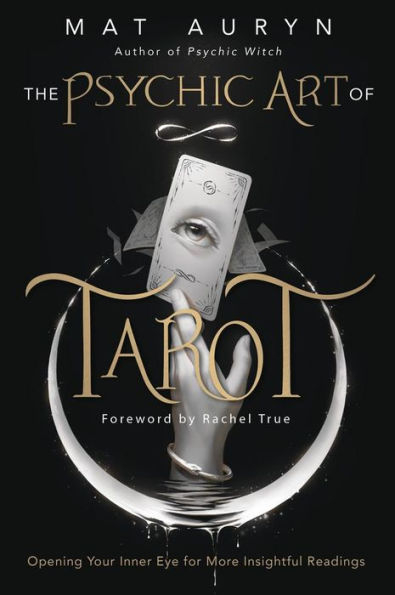Mat Auryn has done it again – offering those of us who love his work a third masterpiece in a row. In 2020, Llewellyn published Auryn’s phenomenal Psychic Witch; then in 2022, his Mastering Magick. Each of these three books may be read as a separate volume, though they are also inter-related and, in my humble opinion, they are essential reading for any occult practitioner.
The Psychic Art of Tarot is a work of both theory and practice. There are 78 detailed exercises woven into chapters on why and how to blend the dual arts of tarot reading and psychic development. Mat Auryn is a decades-long professional psychic and tarot reader. He’s steeped in numerous schools of esotericism. He’s also an incredibly good storyteller and writer. This book reads like a charm.
Auryn begins his new book with a question he often heard when he used to read tarot for clients at metaphysical shops. They’d come in and ask: “Are the readers here psychic or do they use cards?” He’d answer to the effect of what he writes on page 1 of The Psychic Art of Tarot: Psychic and tarot readings, “may technically be separate practices” but they work better together than apart “to provide deeper levels of guidance, insight, and personal growth.”
Up front, Auryn states his firm belief “that every single person possesses psychic abilities.” Such ability can take many forms and likely won’t resemble how being psychic is portrayed in mainstream culture. “Psychism involves perceiving subtle forces,” Auryn writes, and “as a result, the way we experience it also tends to be subtle.” Like any skill, “mastering psychic development parallels the process of mastering any art.” Practice is required.
As for how to practice both tarot reading and psychic development, Auryn recommends reading his new book first all the way through and then working with the exercises, which build on each other. This book, he says, is a “sequential guide” more than a “referential compendium.” Readers won’t learn from this book what the cards mean. For that, there’s an extensive bibliography, and it’s assumed that the reader is already either conversant with tarot, or knows how and where to study to become so.
As for the theory parts of The Psychic Art of Tarot, Auryn explains in detail some key occult concepts, by way of situating tarot and psychism in their broader context. The first term he explains is divinity, as tarot, after all, is an act of divin-ation. “The divine,” Auryn writes, “can be a cosmic force, an inner voice, a connection to ancestors, external entities, or a feeling of oneness with the world, all at once.” Divinity can be found in everything and everywhere. But Auryn also says he’s “inviting you to journey beyond your immediate sense of self and personal identity,” not to deny one’s self but to “connect with something more numinous, powerful, and vast.”
This “something” that is numinous, powerful, and vast is connected to the difference Auryn draws between being intuitive and being psychic, though they often work together. “Intuition emerges from the unconscious processing of sensory details in our environment, leading to a specific insight,” he writes. An intuition may feel like a psychic experience because the “subconscious processing of environmental cues can create a sense of knowing or feeling.” Psychic ability is distinct. It involves “utilizing the clair senses, which operate independently of tangible environmental information.”
One way to cultivate this independent psychic sense—which is what Auryn’s 2020 book Psychic Witch is about-- is to work with one’s three souls: middle, lower, and higher, each soul acting “as a distinct lens that allows us to perceive reality in unique ways, thereby expanding our understanding of the psychic realm.” The first of the 78 exercises in The Psychic Art of Tarot is to contemplate the Sun, Moon and Star cards, to pledge, vow, and commit oneself to embodying, understanding, and listening to the qualities and guidance that come from the three souls. Exercise 2 carries the three-soul practice forward: draw a card and work with its energy, its essence, and its information. Auryn’s detailed instructions make the exercises accessible and adaptable as practices to sink into long-term. Again, Auryn situates the practices of tarot and psychic development within a larger context of occult immersion.
As such, he’s got chapters on energy work--with grounding, centering, and protection exercises-- as well as a chapter on contemplation and meditation, including exercises on skills such a cultivating an alpha state and strengthening one’s ability to visualize. Exercise 22 is a daily card draw. For this one, Auryn notes that “while this practice may seem simple and more suitable for beginners, it’s one of the most powerful methods to familiarize yourself with the tarot’s language and enhance your intuitive abilities. Never underestimate how immensely powerful foundational practices can be over time.”
As the book progresses, so do the exercises. There’s material on how to develop a relationship with your own tarot spirit guide; how to deepen clairvoyance, clairaudience, and the rest of the psychic senses; on the relationship between tarot practice and mediumship, and on and on. This book is packed and juicy! It’s for tarot readers who want to deepen the psychic part of what they do. It’s also for people who don’t read for others but who want to weave divination into a diverse spiritual practice. The artistry, Auryn concludes, is to develop one’s own distinctive style, not a “rigid science.”
The Psychic Art of Tarot is a work of art in its own right.
By the end, Auryn concludes that what a tarot reading does is to “delve beneath the surface, making the invisible visible and giving form to hidden thoughts and feelings…. The psychic art of tarot reveals our inner selves and life’s external mysteries…..The more we engage with tarot, the more instinctively it comes to us.”
~review by: Sara R. Diamond
Author: Mat Auryn
Llewellyn Publications, 2024
283 pages, $19.99

